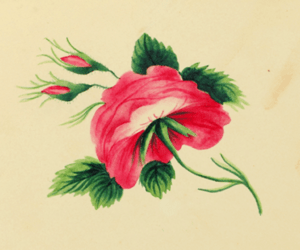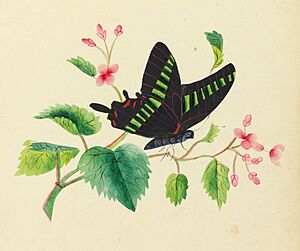Sarah Mapps Douglass facts for kids
Quick facts for kids
Sarah Mapps Douglass
|
|
|---|---|
| Born | September 9, 1806 Philadelphia, Pennsylvania, US
|
| Died | September 8, 1882 (aged 75) Philadelphia, Pennsylvania, US
|
| Known for | Writing; paintings |
Sarah Mapps Douglass (born September 9, 1806 – died September 8, 1882) was an important American teacher, abolitionist, writer, and speaker. An abolitionist was someone who worked to end slavery. Her painted pictures found on her letters might be the first or earliest known signed paintings by an African-American woman. These paintings are part of the Cassey Dickerson Album, a special collection of friendship letters from the 1800s written by a group of women.
Contents
Early Life and Family Background
Sarah Douglass was born in Philadelphia, Pennsylvania. She came from a well-known family who fought against slavery. She was the only daughter of Robert Douglass, a baker, and Grace Bustill Douglass, who was a hat maker and teacher.
Her grandfather, Cyrus Bustill, was a Quaker who owned a bakery. He also ran a school from his home. He was one of the first members of the Free African Society, which was an early charity group for African Americans. Sarah grew up among Philadelphia's important families. She received a lot of private lessons when she was a child.
Sarah was part of the Bustill family in Philadelphia. Her brother was the artist Robert Douglass Jr.. They even shared advertising space at his shop where their family lived. Her cousin was also an artist named David Bustill Bowser.
Education and Teaching Career
In the early 1820s, Sarah went to college. After that, she taught for a short time in New York City. In 1825, Douglass started teaching in Philadelphia. She taught at a school that her mother and James Forten had helped to start. James Forten was a wealthy African-American sailmaker. Sarah had also attended this school when she was a child.
Starting in 1833, she taught briefly at the Free African School for Girls. Soon after, she opened her own school for African-American girls. She quickly became known as a very talented teacher of science and art. She also expected her students to work very hard.
In 1838, the Philadelphia Female Anti-Slavery Society took over her school. They kept Douglass as the head teacher. In 1854, her school joined with the Institute for Colored Youth (which is now Cheyney State University). Douglass became the head of the primary department there. She held this job until she retired in 1877.
As a teacher, she believed that girls should have the same chances to learn as boys. She taught subjects like math and science, which were usually only taught to boys back then. She loved science herself. She even kept her own collection of shells and minerals in her classroom for her students to study.
Activism and Fighting for Rights
Sarah Douglass began her work as an activist as early as 1831. When she was 25, she helped collect money to send to William Lloyd Garrison. This money supported The Liberator, an anti-slavery newspaper. She also wrote for this newspaper.
Douglass also helped create the Female Literary Association (FLA) in 1831. This group was made up of African-American women. They wanted to improve their skills and feel a stronger connection to enslaved women. Black literary societies like the FLA started forming in cities in the Northern United States in the late 1820s and early 1830s.
These groups used reading to gain knowledge. They used writing to express themselves, record information, and talk to other Black people. This included those who could read, those who could read a little, and those who could not read at all. These societies believed that for the community to do well, people needed to come together. This would create a sense of shared identity and spread important knowledge to the Black community, both free and enslaved.
Douglass was one of the leaders of the FLA. The FLA was the first social library especially for African-American women. It gave Black women a place to share important readings and their own writings. The Female Literary Association encouraged self-improvement through education for everyone. This included those who could read and those who could not, and both free and enslaved people.
They believed that education would challenge the idea that African Americans were not as smart as white people. Douglass and the women of the Association thought that "improving intellectual powers" was the most important thing a person could do. They believed God gave these talents. It was their duty as women and African Americans to use these talents to break down barriers. They wanted to fight for equal rights to help their race move forward.
The members of the Female Literary Association met every Tuesday. Their meetings were for reading and reciting. This was for "mutual improvement in moral and literary pursuits." William Lloyd Garrison, who supported them, said that almost all members wrote original pieces each week. They put these anonymously into a box, and a committee would then discuss them. Douglass herself often wrote prose and poetry. Much of her work was published in the "Ladies' Department" of The Liberator, The Colored American, and the Anglo-African Magazine. She used the pen name Zillah and possibly also "Sophonisba."
In 1832, Douglass gave a speech to the Association. She explained how she became an activist with the Female Literary Association: "One short year ago, how different were my feelings about slavery! It is true, the cries of the enslaved sometimes reached my ears. They made my heart hurt for their suffering. But, sadly, the feeling disappeared quickly. I had created my own small world and did not want to leave it. But how everything changed when I saw the oppressor hiding near my peaceful home! I saw his strong hand reaching out to grab me. Then, the cause of the slave became my own. I stood up and, with a great effort, shook off the laziness that had covered me for years. I decided, with God's help, to do everything I could to improve the lives of my wronged and ignored race."
Working for Abolition
With her mother, Sarah was a founding member in 1833 of the Philadelphia Female Anti-Slavery Society. This group included both African-American women, like Douglass, and white women, like Lucretia Mott. The group's goal was to completely end slavery as soon as possible. They did not believe slaveholders should be paid for freeing their enslaved people. They also wanted equal civil and religious rights for Black people in the United States.
On December 14, 1833, the society finished writing its Constitution. It stated that they felt it was their duty "as Christians to show their hatred of the terrible unfairness and deep sin of slavery by working together strongly." Any woman who agreed with these ideas and contributed to the Society could become a member.
The Society's members read several anti-slavery newspapers. These included Garrison's The Liberator and The Emancipator. They shared these among members and their friends. The Society also gathered a small library of anti-slavery books and pamphlets to share. Within its first year, it also started a school for African-American children.
The Society also encouraged people to avoid buying goods made by enslaved people. They also asked Congress to end slavery in the District of Columbia and other federal areas. They also wanted to stop the slave trade between American states. By 1840, Douglass had served in many roles in the group. She was on the board of directors, on the committee for annual fairs, on the education committee, and was a secretary, librarian, and manager.
Later Life and Medical Studies
From 1853 to 1877, Douglass studied anatomy, women's health, and hygiene. She also received basic medical training. She studied at the Female Medical College of Pennsylvania, becoming the first African-American female student there. She also studied at the Ladies' Institute of Pennsylvania Medical University. Her studies influenced her decision to give talks and teach evening classes to African-American women. These classes were at meetings of the Banneker Institute and focused on topics like how the body works and staying healthy.
In 1855, she married William Douglass. He was an African-American rector, or minister, at the African Episcopal Church of St. Thomas. He was a widower with nine children. After her husband died in 1861, Sarah Douglass went back to her anti-slavery work and full-time teaching.
She passed away in 1882 in Philadelphia.
In Popular Culture
- Sarah Mapps Douglass is a main character in Ain Gordon's 2013 play If She Stood. This play was created for the Painted Bride Art Center in Philadelphia.
See also
 In Spanish: Sarah Mapps Douglass para niños
In Spanish: Sarah Mapps Douglass para niños



